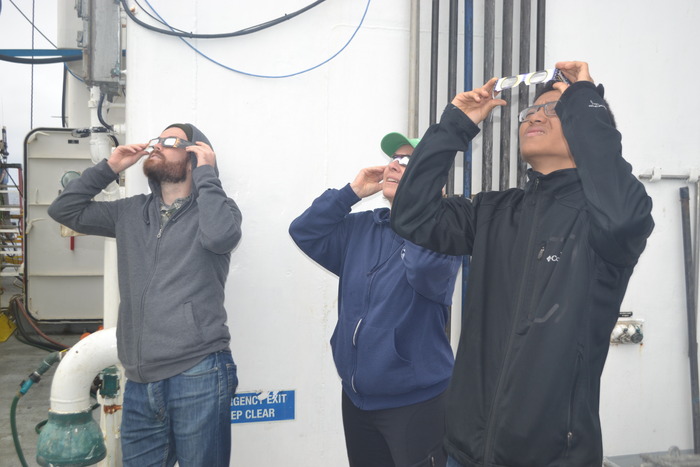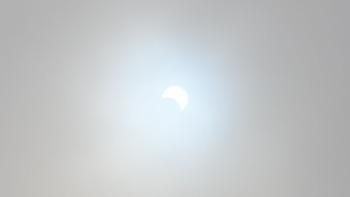The final leg of the 2017 OOI Cabled Array (CA) O&M Cruise (RR1715) got underway at approximately 12:30 pm PDT on Sunday (Aug 20th) as the R/V Revelle pulled away from the NOAA dock in Newport, OR and headed out past the jetty into unprotected water. The wind was quite blustery and a persistent swell resulted in a bumpy start to the ~24 hr transit to the Axial Caldera. The significant roll of the ship that occurs while transiting in a direction nearly parallel to the waves, also known as being “in the trough”, had some of our new student participants feeling a bit under the weather. Most of them, along with many scientists and engineers, turned in early and used the extended transit time as an opportunity to catch up on sleep.
Beginning around 0900 PDT the next morning (Aug 21st ), most of the VISIONS’17 crew were standing on the back deck waiting for the solar eclipse. While our transit put us in a perfect position to witness the event in totality and the early morning weather looked promising, it quickly clouded over as the magical moment arrived. Although the clouds and mist obscured a clear view of the fully eclipsed sun, the striking darkness that quickly enveloped the ship at the critical moment left a significant impression on all of us. A bit later, the cloud layer thinned enough to provide a view of the partial eclipse.
We arrived at Axial Caldera at 1415 PDT to begin the first operations of this leg. The ROV Jason entered the water at 1520PDT for Dive J2-1006 and began its descent to ~1575 m where it repositioned the High Definition Video Camera (CAMHD) deployed last leg and situated alongside the hydrothermal vent “Mushroom” in the ASHES District of the Axial Caldera. This dive took about 5 hours to accomplish.
The next dive, J2-1007, will visit the International District of the Axial Caldera and finish the installments of the dissolved gas mass spectrometer (MASSP) and hydrothermal fluid and particulate DNA samplers (RASFL and PPSDN, respectively). Two additional instruments (TRHPH and THSPH) that are designed to provide real-time temperature and chemistry data from high-temperature (>150°C) hydrothermal vents will also be deployed. The deployment and positioning of these two probes will be a slow process, as they need to be warmed up incrementally to avoid thermal shock to the enclosed ceramic components.



